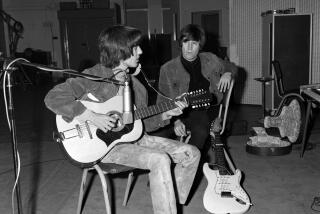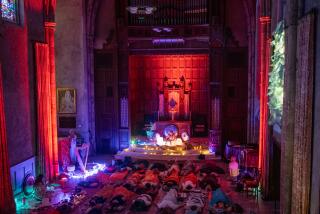Reverence for Sacred Sound
The organ pipes spill from Mission San Juan Capistranoâs Serra Chapel like handkerchiefs out of an old vaudevillianâs sleeve, one leading to another and then another until a whole river of fabric tumbles out.
In this case, the pipes emerge from a 12-by-8-foot room in the loft at the rear of the high, narrow chapel. There are more than 500 pipes in all, the smallest the size of a pencil and the largest 8 feet tall and 10 inches across.
Some of the pipes are made of wood, but most are metal. Lined up in half a dozen low, flat pine boxes that Frank and Shaun Kieran use to carry them outside for cleaning, the pipes look like a delivery by a weapons smuggler. But these weapons sing. And the Kierans are here to restore their voices.
âI feel that this is a kind of higher calling in my life,â says Shaun Kieran, 30, of San Clemente. âIf the organist does her job and I do my job, then people worship God.â
In an effort fueled as much by personal passion as business, the father-and-son organ restorers will spend three weeks cleaning and adjusting the pipes, retooling the 42-year-old organâs electrical heart and resealing the wood-and-leather chambers that form the instrumentâs lungs.
In a way, their work is rooted in the past, bringing fresh life to musical instruments built in different eras. Pipe organs need to be refurbished every 50 years or so, experts say. Fluctuating temperatures and humidity, plus the buildup of dust and pollutants, affect everything from how air moves through the pipes to create sound to how the keys respond to the organistâs touch.
It can be expensive work. Mission San Juan Capistrano will spend about $18,000 restoring the Serra Chapel organ, which cost $8,500 to install more than 40 years ago. But it would cost more than $100,000 to replace it, said Chris Leaver, vice president of marketing and sales for Reuter Organ Co. of Lawrence, Kan., which built the Serra Chapel organ.
Restoring the organ will be faster too. Experts say the pipe organ industry has been laboring lately under the weight of its own success. Following a crunch in the early â90s in which a number of organ makers closed down, demand for new pipe organs--primarily by churches and schools--has outpaced the small industryâs ability to deliver.
Some companies have backlogs of more than two years, said Robert Ebert, an economics professor at Baldwin-Wallace College in Ohio and the author of annual reports on the pipe organ industry.
*
Still, demand for pipe organs is below what it was a generation ago, when major manufacturers employed 1,000 workers. The biggest organ makers now--there are about 10--employ about 60 people, and the $130-million organ industry itself is split almost evenly between pipe organs and electronic organs, which use computers to create sound.
Still, itâs a limited market, with about 120 pipe organs built nationwide each year, compared with 3,650 electronic organs, which can cost a fraction of the amount for a full pipe organ, Ebert said.
This is where the real change in the industry has come, one welcomed by the technically inclined but reviled by those who believe, as does Ebert, that a pipe organ âstirs the soulâ in a way that digitally sampled music cannot.
The new electronic organs use computer chips to produce the notes. Proponents say the tones are indistinguishable from those of a true pipe organ. Purists, though, say the digital instruments fill the room with artificiality. A pipe organ, when properly installed and tuned, they say, creates an enveloping sound that you feel as much as hear.
Before the Serra Chapel organ was disassembled earlier this month, its sound was rough and a little wheezy. Leaks in the cracked and worn leather seals left the air pressure inconsistent and unreliable, the notes themselves tenuous and unsatisfying.
As organs go, the Serra Chapel instrument is rather ordinary, lacking the majestic, chest-rumbling intensity of larger machines. But it fits the chapel, a high, narrow chamber insulated from the world by 4-foot-thick walls. Drafts carry the warm scent of dozens of votive candles, each flicker of flame representing an anonymous prayer. Unsmiling statues of saints give the room a somber, reverential feel despite the glistening gold altar that fills the wall opposite the organ loft.
When workers for the Reuter Organ Co. were installing the organ more than 40 years ago, Frank Kieran was a young man on the other side of the country learning the skills he is using now to revive the instrument.
A native of New Jersey, Kieran was raised in state homes after the car-crash deaths of his parents when he was 7. After high school he enrolled in a Bible college in South Carolina, contemplating the ministry. Short of money, he moved to Boston to work and save up to continue his education.
Chance derailed his plans.
âOftentimes, our lives take different turns, and when itâs happening you can be confused and not understand it,â Kieran says. âLater on, you feel it was the hand of God.â
Kieran joined Raytheon as a courier and began attending Plymouth Congregational Church in Framingham, outside Boston. He volunteered one week to help unload the churchâs new pipe organ and met the builder, who invited him back to his shop.
âI went just to see a pipe organ and he handed me a screwdriver,â Kieran says, describing his shift from Bible college to organ rebuilding as a change in ministry. âIt just seemed to all fall together for me to do that. I was just intrigued to be in a whole world that I never knew existed.â
Thereâs more to the trade than simply picking up a screwdriver. The core of the instrument is simple. The first organs were devised in ancient Greece, using bellows to push air through pipes. But the evolution of the instrument added complexities.
Kieran said it used to take about seven years for a newcomer to develop the skill to restore an organ, and the ear to tune one. Now, with the increased use of electronics--low-voltage charges open and shut valves--it takes 12 years to become adept.
âItâs a traditional business but also a changing business, ever evolving,â Kieran says. âThereâs always something to learn and always a skill to refine. I donât think anybody ever gets to the point where heâs perfect.â
Kieran moved to Southern California in the late â70s to work as a regional representative for an organ manufacturer before stepping out on his own about 15 years ago. His son has been working with him for about eight years in the San Clemente-based business. His daughter used to work in the firm too but now is completing a doctorate in communications law at Pepperdine University. Kieranâs wife died of cancer about 10 years ago.
*
For the Serra Chapel project, the Kierans disassembled the pipes and toted them outside near the graveyard for cleaning. Using a portable compressor, they blasted air through the tubes to clear them of dust, then smoothed out nicks that can affect the sound, cleaned off thin layers of rust and spray-painted a finish over areas prone to rusting. About 16 tubes, some of them missing, will be replaced.
The cleaning is critical.
âAn eighth of an inch of dust will foul up the pipeâs speech,â Kieran says.
Upstairs, the father and son have replaced the leaky leather seals that allow the air reservoir to rise as it fills, cleaned grit from electrical contacts and traced all the connections to make sure they work.
After putting the pipes back in place comes the tuning, a delicate regimen of note-playing by the son at the keyboard as the father crawls into the pipe room to adjust the metal sleeves that top each pipe and control the pitch of each note.
Hitting the exact pitch isnât enough. Each pipe organ is customized for the room in which it plays, with air pressure modulated for sufficient power to fill the room without overwhelming it. So the Kierans in essence are tuning not only the pipes but the room itself.
Itâs a delicate task. And when done right, no one will notice. Frayed and wheezing notes stand out; clean and perfectly pitched tones do not. They wash over the listener, a transporting experience in which the music itself can seem alive.
Kieran likes to think that each instrument he and his son restore also carries the whisper of their own voices, a deeply personal but invisible legacy.
âWe feel like we leave a little bit of ourselves behind in that organ,â Kieran says.
More to Read
The biggest entertainment stories
Get our big stories about Hollywood, film, television, music, arts, culture and more right in your inbox as soon as they publish.
You may occasionally receive promotional content from the Los Angeles Times.











